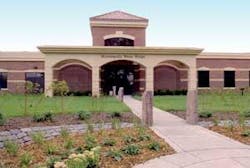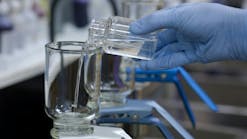Click here to enlarge imageWith a current capacity of 70 million gallons per day (mgd) and ultimate capacity of 78 mgd, the Black & Veatch-designed Columbia Heights membrane filtration plant is second in size only to a 72 mgd membrane facility in Singapore, also designed by the global engineering, consulting and construction company.
“Ultrafiltration was a logical choice for physical pathogen removal and multiple-barrier protection at a reasonable cost,” said Dr. Rezania. “Successfully applying a relatively new technology at such a large scale to existing operations presented many challenges, but the collective managerial skills and technical knowledge of everyone involved in this project enabled us to rise to those challenges and ensure the people of Minneapolis and nearby suburbs a continued supply of good quality drinking water well into the future.”
The decision to replace existing granular media filters with UF to further treat lime-softened, clarified, variable-quality water from the Mississippi River was prompted by multiple goals and considerations. These included the need to address future contamination threats, continue to comply with regulatory requirements and replace nearly century-old treatment facilities. The new membrane filtration plant is producing low-turbidity water that is better than regulatory standards require, and it will protect MWW customers from waterborne disease by providing high-log removal of microbial pathogens such as Cryptosporidium.
“Working with a client of this caliber on a project of this significance was very rewarding,” said B&V Water President and CEO Dan McCarthy. “The opportunity to couple global membrane technology experience with specific understanding of local water issues maximizes the value of this project and results in a satisfied client - and ultimately satisfied customers. Working with the MWW to effectively utilize and advance membrane treatment not only benefits area residents but also the water industry as a whole.”
Growing interest in membrane filtration by communities around the world has spawned an increase in not only the number but also the size and sophistication of membrane facilities. With completion of the MWW UF plant, Black & Veatch has provided study, design, construction and startup services for the two largest membrane filtration facilities in the world treating potable water. The award-winning Chestnut Avenue Water Works extension project in Singapore features an immersed membrane system and continues to hold the world record in current operation capacity.
According to Black & Veatch Membrane Practice Leader Jonathan Pressdee, who served as the company’s Columbia Heights project manager, the newly operational MWW plant further establishes membrane filtration as an economically viable technology. In fact, recent Black & Veatch projects in North America have shown membrane filtration to be not only affordable but even lower in cost than traditional filtration processes.
The Columbia Heights UF plant project team incorporated advanced design tools as well as filtration technology in the upgrade of the existing water treatment facilities, using innovative 3-D design, virtual reality software, and an effective internet-based communications approach. While the exterior was designed to aesthetically complement the historic existing facilities, the new building houses contemporary control, laboratory and educational facilities as well as 40 UF units supplied by Ionics, Inc. (now part of GE Infrastructure, Water & Process Technologies) and associated storage and feed equipment for membrane cleaning. WW
NSF Standard Accepts Stainless Steel Materials in Drinking Water
NSF International has announced that NSF/ANSI Standard 61: Drinking water system components - Health effects now allows additional types of stainless steel as acceptable materials for use in the manufacturing of drinking water equipment.
Duplex stainless steel grades 2205, 2304, 2101 and 2003 have been incorporated into the standard. These are in addition to types 304, 304L, 316 and 316L, which have previously been accepted under NSF/ANSI Standard 61.
“The incorporation of these stainless steel grades allows drinking water treatment and distribution equipment manufacturers greater latitude in selecting stainless materials for products that are certified to NSF/ANSI Standard 61,” according to Dave Purkiss, general manager of NSF’s Drinking Water Treatment and Distribution Systems Program.
NSF/ANSI Standard 61 is the American National Standard that ensures pipes, tubes, storage tanks and other products that come in contact with drinking water do not contribute levels of contaminants that could cause serious health problems. Forty-five U.S. states and two Canadian provinces require drinking water system components to comply with NSF/ANSI Standard 61 requirements.
The NSF/ANSI Standard verifies that stainless steels are highly resistant to leaching of contaminates into potable water. To verify the acceptability of stainless steel, NSF tested randomly selected samples from stainless steel manufacturers. The samples underwent an aggressive three-week exposure period according to the requirements of NSF/ANSI Standard 61. Collected water samples were analyzed for a wide range of contaminants including lead, arsenic and chromium.
The modification of the standard was approved by the NSF Joint Committee on Drinking Water Additives, which oversees NSF/ANSI Standard 61, and the NSF Council of Public Health Consultants, an independent advisory group of professional and regulatory officials who review all NSF standards to ensure they provide public health protection. The additional section can be found in Annex C of NSF/ANSI Standard 61: 2005.
American Water Leads Research Projects
American Water, the largest water services provider in North America, has received funding for two research projects. The projects, which total $1.3 million, are being funded, in part, by the American Water Works Association Research Foundation (AwwaRF).
For the first project, American Water will work with HDR Engineers, Clancy Environmental Consultants, Ecole Polytechnique, and Dalhousie University to evaluate bacterial management plans. The project team will develop a guidance manual to help utilities track and control coliform bacteria in water distribution systems. Nationwide, exceeding the Total Coliform bacterial standard is the most common drinking water violation experienced by public water systems, affecting over 11 million people.
“American Water has an excellent record of Total Coliform compliance, in part due to extensive research on the topic in the 1980s and 1990s,” said Dr. Mark LeChevallier, director of research and environmental excellence at American Water. The project began in late-January 2006 and is scheduled for completion in two and a half years.
The second project, which will span the next two years, will elevate recently introduced leak detection technology to the next level. Working with the National Research Council of Canada, Flow Metrix and Hexagram, American Water researchers will use Automatic Meter Reading (AMR) systems to monitor and analyze acoustic vibrations in pipes, predicting if and when the pipes will burst.
Project Manager David Hughes, an infrastructure engineer at American Water, explains that “if we can confirm that leaking water pipes go through several stages of progressive failure, then water utilities can proactively manage water main failures and schedule repairs within the distribution network.”
Leaks are a problem plaguing public water systems nationwide. The ability to manage leaks and predict when breaks might occur is instrumental to the preservation of water utility infrastructure.
More information about the AWWA Research Foundation Awards can be found by visiting www.awwarf.org.



